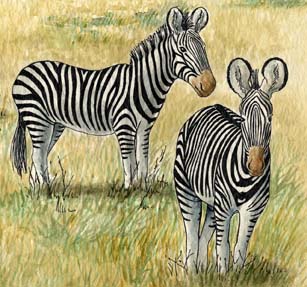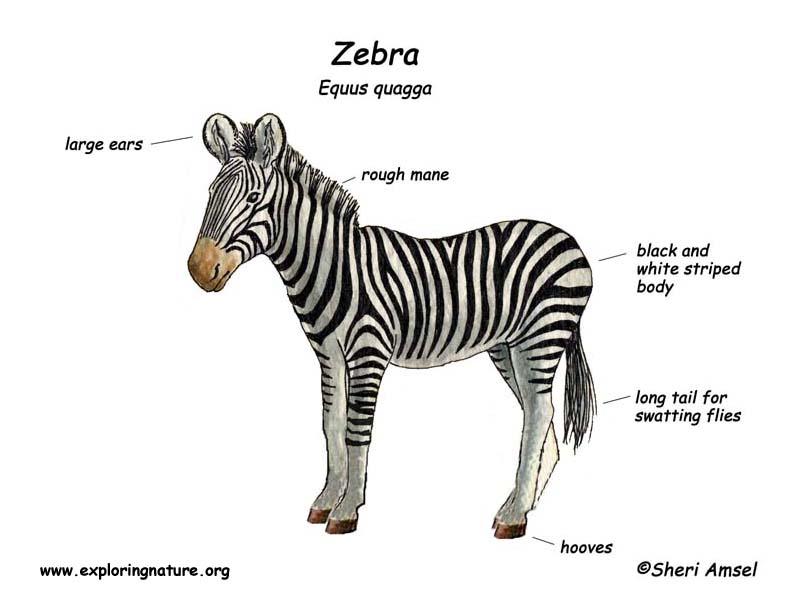

Zebras are found in eastern and southern Africa. There are 4 species of zebra: plains or Burchell's (common) zebra, Grevy's Zebra, mountain zebra, and the quagga (extinct).
They are found on open, grassy plains or savannahs, open woodlands and grassy mountain slopes. They share their range with other grazers like wildebeest, gazelles, oryx and antelope.
Zebras can grow to almost 5-feet tall at the shoulder. They can weigh as little as 400 pounds and as much as 900 pounds (males are bigger than females)!
Zebras have a barking whinny to warn of approaching predators and even post a lookout at night while others sleep.
They eat mostly grasses, with some leaves and twigs. They migrate according to how much food and water is available (herbivores).
Predators include leopards, cheetahs, lions and crocodiles.
Males compete for groups of mares (harems) by fiercely kicking and biting. Males without harems live in bachelor groups. Females are pregnant for 1 year (gestation) and give birth to 1 foal (rarely twins). They breed again right after giving birth. Foals can stand right after birth and can run within a few hours. Half of the zebra foals born each year are eaten by predators.
Zebras live 20-30 years in the wild. Burchell's zebra are listed as Lower Risk - least concern. Mountain zebra are listed as endangered. Grevy's Zebra are listed as endangered. The Quagga is extinct.
Burchell's Zebra -
Kingdom: Animalia
Phylum: Chordata
Subphylum: Vertebrata
Class: Mammalia
Order: Perissodactyla
Family: Equidae
Genus: Equus
Species: Equus burchellii
Mountain Zebra -
Kingdom: Animalia
Phylum: Chordata
Subphylum: Vertebrata
Class: Mammalia
Order: Perissodactyla
Family: Equidae
Genus: Equus
Species: Equus zebra
Grevy's Zebra -
Kingdom: Animalia
Phylum: Chordata
Subphylum: Vertebrata
Class: Mammalia
Order: Perissodactyla
Family: Equidae
Genus: Equus
Species: Equus grevyi
Quagga -
Kingdom: Animalia
Phylum: Chordata
Subphylum: Vertebrata
Class: Mammalia
Order: Perissodactyla
Family: Equidae
Genus: Equus
Species: Equus quagga
When you research information you must cite the reference. Citing for websites is different from citing from books, magazines and periodicals. The style of citing shown here is from the MLA Style Citations (Modern Language Association).
When citing a WEBSITE the general format is as follows.
Author Last Name, First Name(s). "Title: Subtitle of Part of Web Page, if appropriate." Title: Subtitle: Section of Page if appropriate. Sponsoring/Publishing Agency, If Given. Additional significant descriptive information. Date of Electronic Publication or other Date, such as Last Updated. Day Month Year of access < URL >.
Amsel, Sheri. "Zebra" Exploring Nature Educational Resource ©2005-2024. December 14, 2024
< http://mail.exploringnature.org/db/view/378 >

